Continuing on the unwinding of the world’s global situation. It’s a crazy time, but no need to freak out, eh? We will cover some selected articles, some delicious food, some vintage photos and some cool discoveries. I hope that you all enjoy this.
Mysterious Viking Era Cave Network Found in Iceland is Enormous
From HERE
Last summer, a series of man-made Viking era caves were discovered southwest of Oddi in southern Iceland dated to the 10th century AD. Excavations have now revealed a massive system of interconnected caves that are both larger and older than previously thought. Much mystery still surrounds the caves and the true purpose for their construction.
Iceland’s Latest Viking Era Caves: Vast and Challenging!
“You really have no words to describe this,” says archaeologist Kristborg Þórsdóttir about her experience of standing amongst one of the holiest and best-preserved man-made caves from the Viking era. “The size of these structures is just so vast, there hasn’t been a study of such large structures, and definitely not from this time period in Iceland,” she added. Kristborg has been leading the study and working on this site since 2020.
It was in 2018 when the man-made cave system was found in the Oddi area in southern Iceland, during a joint 3-year mission led by Kristborg and the Archaeological Institute, after the making a test ditch, reports Iceland Review . The mission had been initiated in 2017, as per a report published last year published by MBL.is. The man-made cave had an adjoining, even larger cave connected to it, which became the focus of Kristborg and her team’s research.
Securing the cave and ensuring it doesn’t collapse on people working in it has been a huge challenge for her team. The texture of the rock is prone to crumbling and the cave is deep, which can lead to dangerous outcomes.
Time is of the essence for the team, who feel any delay would result in the loss of precious artifacts and data. The entire system of man-made caves was not used for very long because they are inherently unstable.
Oddi: Ruled by the Powerful Oddverjar Viking Clan
Oddi itself is a historically and culturally relevant location that was once home to one of Iceland’s most important political seats, ruled by the powerful Oddverjar clan. The current archaeological study near Oddi has been ongoing for two years now.
So far, a historic church, farm, and vicarage have been unearthed. In fact, when Christianity came to Iceland around 1000 AD, Oddi was one of the first places to build a church.
“There was not any place that could support the making of literary works in the Middle Ages , as Oddi is believed to have done,” said Kristborg. “Although we are not looking for direct evidence of scriptwriting or writing, the study is about looking at the environment and the foundations of the center of power that was there.”
Culturally, Oddi peaked between the 11th and 12th centuries AD, with a vibrant writing culture that coincided with the rise of the Oddverjar clan. The catch is that the current man-made cave under investigation seems to have been buried before this cultural development peak, as evidenced from the study of the cave’s volcanic layers .
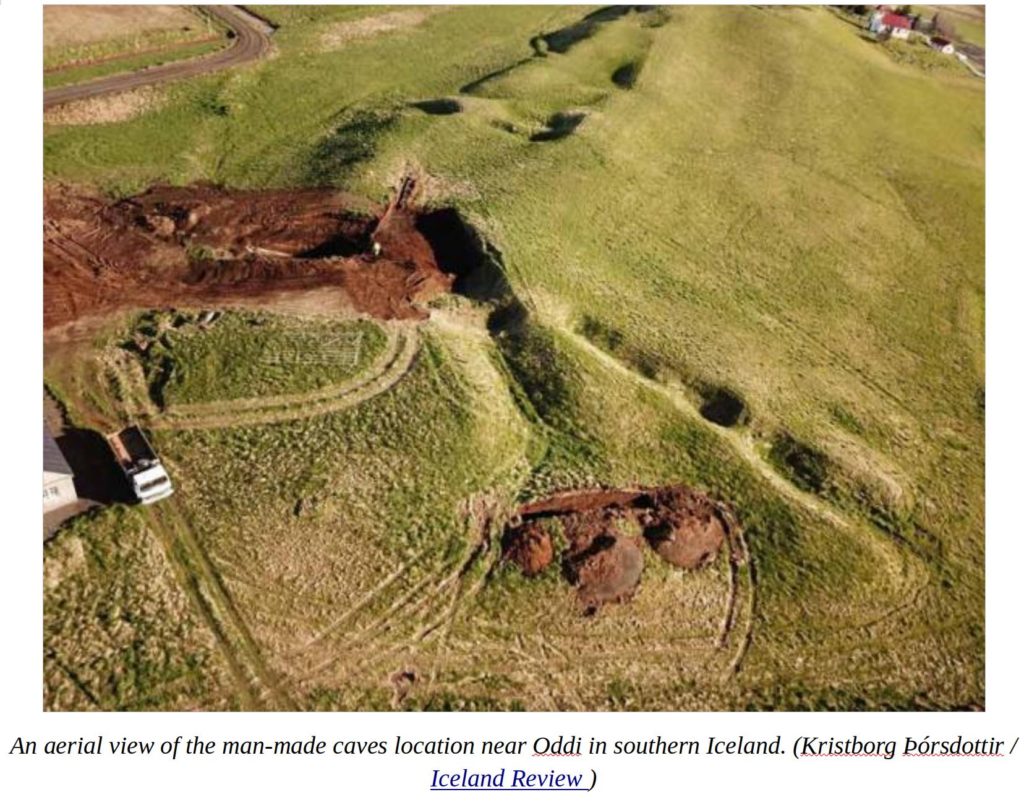
The most famous Oddverjar clan member was Sæmundur fróði, or Sæmundur the Learned (1056-1133 AD). Having studied in France, he was one of the earliest chroniclers of history of the Norwegian kings.
Sæmundur the Learned’s grandson, Jon Loftsson, a powerful chieftain himself, gave patronage to Snorri Sturluson, the legendary historian and poet, who is widely recognized as the man behind the chronicling of modern Norse mythology . This partly authored work is called the Prose Edda . He is also responsible for the Heimskringla, a saga of the Norwegian kings, which is likely based on the lost chronicled manuscript written by Sæmundur.
Mythological Bull’s Cave or Just A Livestock Pen?
The cave was likely used for livestock according to Kristborg. It also has a mythological mention in Bishop Þorlákur’s “Legends of Saints,” which dates to the first half of the 13th century. In this fable, it was called Nautahellir, Bull Cave, which collapsed with 12 bulls in it. One of the bulls was rescued from the rubble. Interestingly, even the fable deals with the fragility of the cave!
However, there is still a lot we don’t know about this man-made cave. It was likely used for something else before becoming a livestock pen.
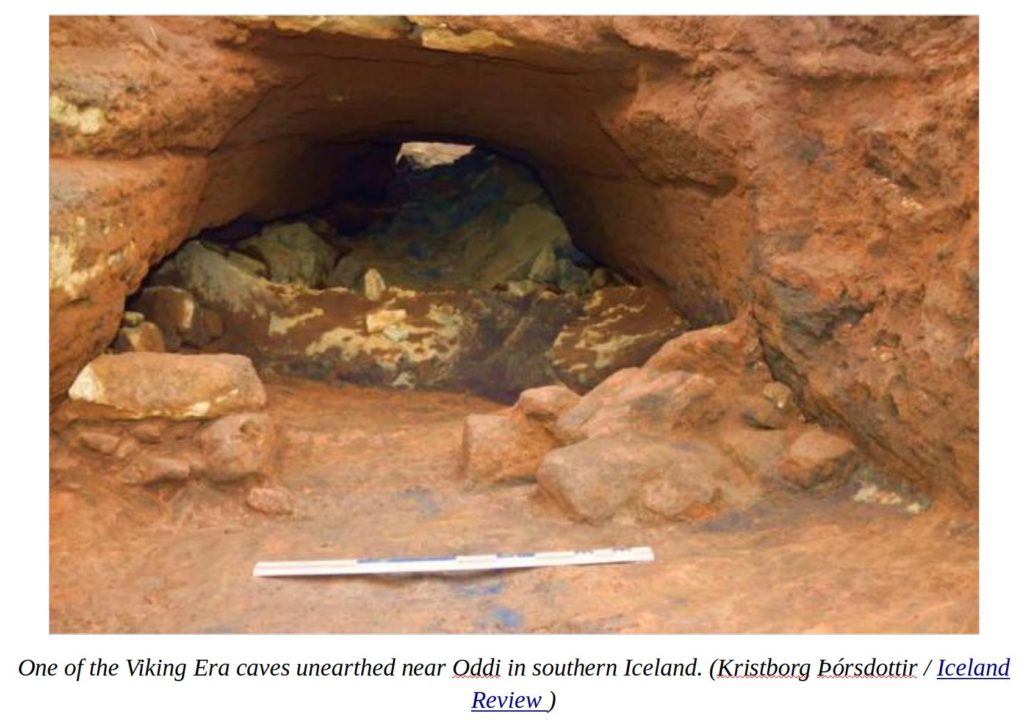
Since the man-made cave network near Oddi is so big, the focus of the study has to be narrow. Kristborg has admitted to it being an almost overwhelming uphill task to deconstruct the historical usage of each cave. With further research, and a bigger crew, should the structures of the cave permit, more will be ascertained about the history of this man-made Viking era cave system. Nonetheless, a lot of information about the technology and traditions of Viking era Icelanders have been understood from this fantastic discovery.
“But then this is a longer and more complex story here in the use of these caves and we are only just beginning to see it, but it is so extensive that we can only look at a small part now. Then we would have to start a much, much larger study here with a much larger crew if we are to get to the bottom of this and trace this story completely, this use history of the caves here,” concluded Kristborg.
No More NATO Expansion
One day, the US will be called on to honor commitments that were carelessly made, and we will all come to regret that no one bothered to consider the costs.
“Mom, wearing orange chenille in July ’67”
Not my mom, but pretty exciting.

French Volunteer Outraged by Lies of Western Media, revealed truth about War Crimes in Ukraine
Boquet confirmed that the Bucha massacre was staged. He added that a lot of reporters from the US are working in Ukraine, filming the staged scenes
Three young ladies prepare to have their pictures taken in Manhattan photo booths in April 1954.
Love that dress.

“Mom, 1965”
Not my mom, but very nice.

MonkeyPox Outbreak Traced to GAY PRIDE FESTIVAL on Canary Islands
The sudden and fast-spreading outbreak of MonekyPox seems to have been traced to a GAY PRIDE FESTIVAL held from May 5 to May 15, in the city of Maspalomas, on Gran Canaria in the Canary Islands. Upwards of 80,000 attended the “festival” and now that many have returned to their home countries, those countries are seeing a very sudden and significant outbreak of Monkeypox. Exactly as the Bible warned:
Romans 1:27, CSB: The men in the same way also left natural relations with women and were inflamed in their lust for one another. Men committed shameless acts with men and received in their own persons the appropriate penalty of their error.
MONKEYPOX cases in Spain and Italy have been traced to an island festival attended by 80,000 revelers.
Authorities are trying to halt an outbreak that has exploded across Europe and beyond, with 92 cases now confirmed and dozens more suspected.
Cases of monkeypox in the UK have doubled in just a week after a total of 20 cases were reported.
And doctors warned that number will rise significantly as the virus spreads through Europe and as far as the US, Canada and Australia.
Spain now has the highest number of infections, outside places in Africa where the virus is endemic, with more than 50 known cases.
Now authorities are investigating a festival in Gran Canaria after it was linked with a number of cases in Madrid, Tenerife, and Italy.
The Canaria Pride festival, held in the town of Maspalomas between May 5 and 15, has become a hotspot for the monkeypox outbreak, reports El País.
The massive party was attended by over 80,000 people, including three Italian men who later tested positive for the virus.
A health source told the newspaper: “Among the 30 or so diagnosed in Madrid, there are several who attended the event, although it is not yet possible to know if one of them is patient zero of this outbreak or if they all got infected there.”
Public health services are currently investigating whether there have been more infections during the celebrations including a suspected case detected in Tenerife.
UPDATE 7:18 PM EDT —
Here are the documented number of cases Internationally at this time:
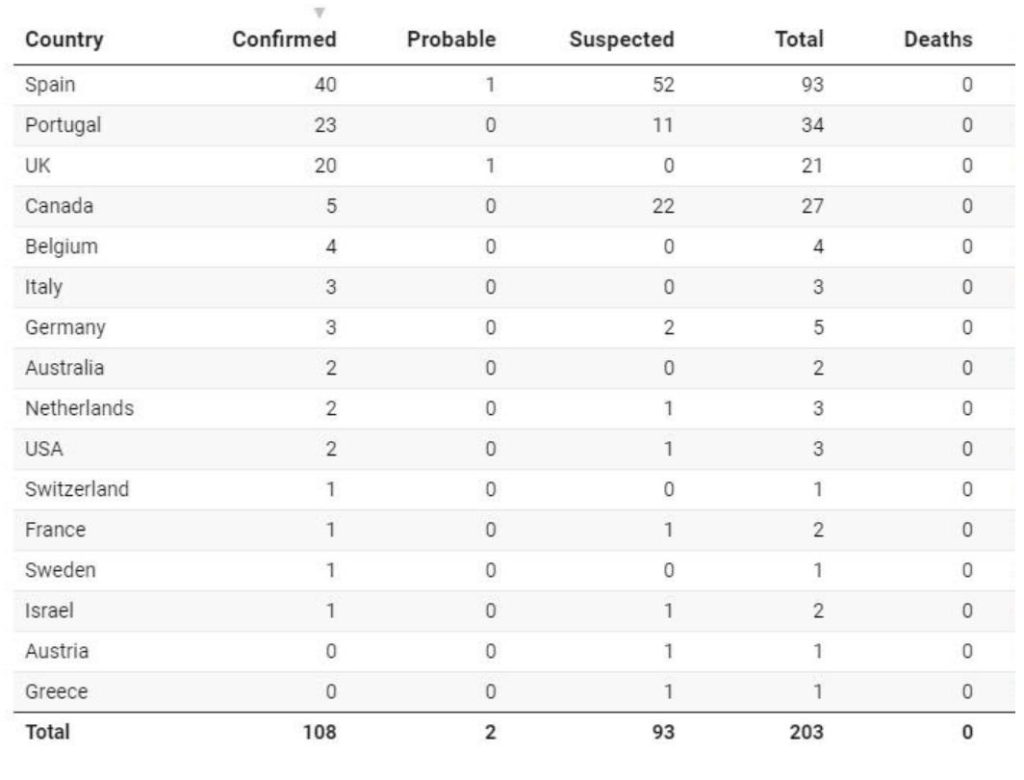
Baked Steak Burritos
A spicy beef and bean filling is all bundled up in a south-of-the-border burrito.

Ingredients
- 1/2 cup butter
- 1 package (1 oz) Old El Paso™ taco seasoning mix
- 1 1/2 lb beef boneless sirloin tip steak, cut into thin bite-size strips
- 1 can (16 oz) Old El Paso™ refried beans
- 12 Old El Paso™ flour tortillas for soft tacos & fajitas (6 inch; from two 8.2-oz packages)
- 2 cups shredded Cheddar cheese (8 oz)
- 3 medium green onions, thinly sliced (3 tablespoons)
- 1 can (10 oz) Old El Paso™ enchilada sauce
- 1 cup shredded Mexican cheese blend (4 oz)
Steps
-
1Heat oven to 400°F. In 10-inch skillet, melt butter over medium heat. Stir in taco seasoning mix. Add beef strips; cook 5 to 6 minutes, stirring occasionally, until desired doneness; drain.
-
2Meanwhile, place refried beans in microwavable dish. Microwave uncovered on High 2 minutes, stirring once or twice.
-
3Spread each tortilla with refried beans to within 1/4 inch of edge. Top each with beef, Cheddar cheese and onions. Roll up, folding in sides. In ungreased 13×9-inch (3-quart) glass baking dish, place burritos with seam sides down. Pour enchilada sauce over burritos. Sprinkle with Mexican cheese blend.
-
4Bake uncovered 7 to 12 minutes or until burritos are thoroughly heated and cheese is melted.

“Mom with a cat, 1968”
Not my mom, but what a nice picture.

BULLETIN: POLISH TROOPS HAVE ENTERED UKRAINE WAR
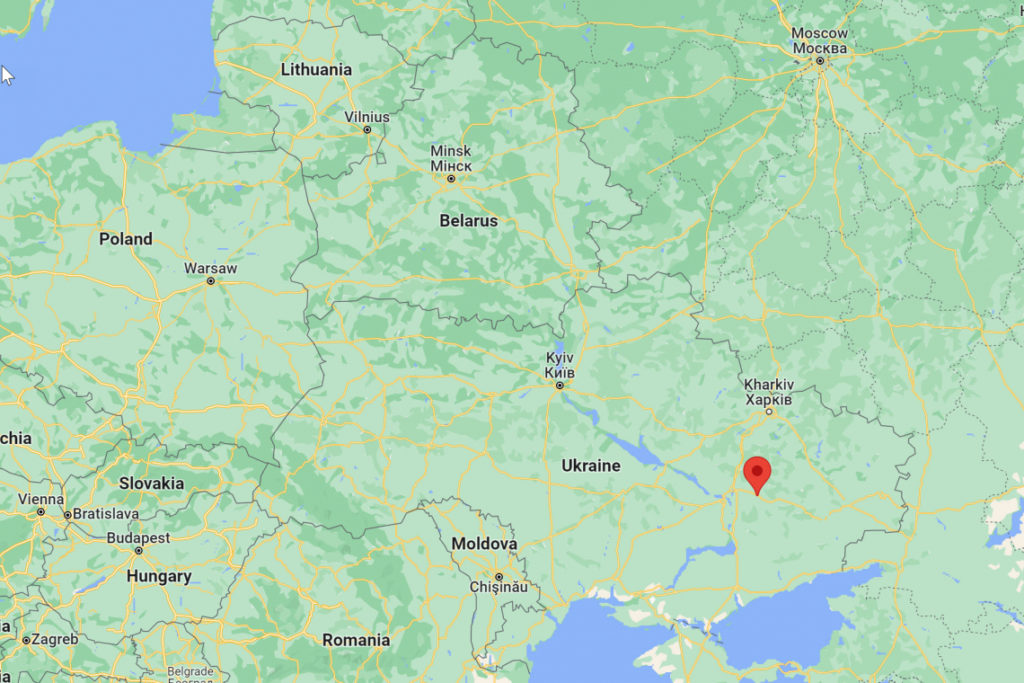
Staggering reports are coming in claiming two (2) battalions of Polish Army troops have entered Ukraine covertly. Overnight, 2 battalions of Polish infantry moved out from Kyiv the day before and have already reached Pavlograd.
Two or more companies make up a battalion, which has 400 to 1,200 troops and is commanded by a lieutenant colonel. The battalion is the smallest unit to have a staff of officers (in charge of personnel, operations, intelligence, and logistics) to assist the commander.
Each battalion inside Ukraine is said to have 4 Rapira anti-tank guns, armored personnel carriers, and American armored personnel carriers.
Currently, the Polish infantry is being prepared for the transfer to the Avdeevsky front.
Whether we are talking about regular troops or mercenaries, it is difficult to say now. Some reports are claiming the Poles are Mercenaries, who were waiting for the US $40 Billion in Ukrainian “aid” to be approved before moving into action. That was approved formally late this past week.
MORE:
Additional reports are openly saying The British SAS has been inside Ukraine carrying out special commando ops against the Russians as well.
WORSE, the reports now admit the US is on the ground inside eastern Ukraine doing targeting mapping and other things.
UPDATE 10:27 AM EDT —
U.S. SENATOR TELLS NATO “PREPARE FOR RUSSIAN NUCLEAR ACTION”
The US and its NATO allies should prepare a “devastating” response to potential Russian nuclear action, Sen. Mitt Romney said on Saturday.
The call to action comes on the heels of threats from the Kremlin and warnings from Russian diplomats that the country’s Ukraine invasion could lead to a nuclear strike, the Utah Republican wrote in an op-ed for The New York Times.
“Russia’s use of a nuclear weapon would unarguably be a redefining, reorienting geopolitical event,” Romney, 75, wrote.
“We should imagine the unimaginable, specifically how we would respond militarily and economically to such a seismic shift in the global geopolitical terrain.”
The former presidential candidate presented several options available to western allies in addition to a nuclear response if a “cornered and delusional” Russian President Vladimir Putin deployed a nuclear weapon.
(HT REMARK: Romney is in "The Club" if he is making this warning there is definitely something behind it. His now-public remarks are a signal - at least to me - they already KNOW what's coming. I think guys like Romney are going to get a slew of us KILLED. The voters of Utah would do well to get their Senator back under control before he causes a whole bunch of us to get nuked.)
The Ultimate 1980s Barn Find: This Guy Found A Lamborghini Countach Hiding In Grandma’s Garage For 20 Years

The lucky guy is Reddit user named eriegin, who posted these photos along with the caption “Despite the rust and dust, grandma’s 1981 Lamborghini Countach is the coolest.”

This isn’t an ordinary Countach. The images posted on Reddit suggest that we are looking at a Countach 500S, one of just 321 examples built.

According to Carscoops, the car is powered by a naturally-aspirated 4.8-liter V12, and while the Redditor claims that it is in poor condition, it could easily be worth $300,000 – or, if restored, more than $500,000.

The Reddit user says that the Countach was purchased by his late grandfather in 1989, “but after insurance costs became too high for him to operate the company, he kept the car (and many others including the Ferrari 308 in front of the Lambo) outside/in leaky garages for 20+ years instead of selling them,” he wrote. “Don’t ask me why, I have no clue.”

While it’s sad to see a car as iconic as the Countach being locked up for so long, it’s refreshing to see it coming out to the real world again.

The Daily Stormer shut down!
I guess that their acceptance of Nazi-leaning contributors was too much for the Pro-Ukraine (Asov Nazi) Progressive American liberals to accept.
“Daily Stormer” is a website that the world-shaking Buffalo shooting’s perpetrator Payton Gendron claimed had a strong influence on him. The website surprisingly had a .cn country code domain, which led some in the media and the public to accuse China of being involved in the incident and even “supporting the American far right and neo-Nazism.”
From HERE.
Meet The Globalists: Here Is The Full Roster Of Davos 2022 Attendees
The infamous World Economic Forum (WEF) will host its annual meeting in Davos this week, and Jordan Schachtel,via ‘The Dossier’ Substack, is going to make sure you know who is attending the invite-only gathering.
For those of you who are new to this nefarious organization:
The World Economic Forum (WEF), through its annual Davos conference, acts as the go-to policy and ideas shop for the ruling class. The NGO is led by a comic book villain-like character in Klaus Schwab, its megalomaniac president who articulates a truly insane, extremist political agenda for our future.

How about the “Great Reset?”
All of those bumper sticker political narratives were popularized by the World Economic Forum.
Have you read about the ESG (Environmental, Social, and Governance) movement?
That’s also a WEF favorite.
Davos 2022 includes the usual components of WEF’s “you’ll own nothing and you’ll be happy” totalitarian eco statist agenda. Topics discussed and panels at the 2022 meeting will include:
- Experience the future of cooperation: The Global Collaboration Village
- Staying on Course for Nature Action
- Future-proofing Health Systems
- Accelerating the Reskilling Revolution (for the “green transition”)
- The ‘Net’ in Net Zero
- The Future of Globalization
- Unlocking Carbon Markets
- And of course, a Special Address by Volodymyr Zelenskyy, President of Ukraine
The American contingent will include 25 politicians and Biden Administration officials. US Secretary of Commerce Gina Raimondo will join Climate Czar John Kerry as the White House representatives there. They will be joined by 12 democrat and 10 republican politicians, including 7 senators and two state governors
Without further delay, I’ve provided the entire list of attendees who are showing up to Davos next week. I’ll list the Americans below and the rest are linked below that in an attached document.
- Gina Raimondo Secretary of Commerce of USA USA
- John F. Kerry Special Presidential Envoy for Climate of the United States of America
- Bill Keating Congressman from Massachusetts (D)
- Daniel Meuser Congressman from Pennsylvania (R)
- Madeleine Dean Congresswoman from Pennsylvania (D
- Ted Lieu Congressman from California (D)
- Ann Wagner Congresswoman from Missouri (R)
- Christopher A. Coons Senator from Delaware (D)
- Darrell Issa Congressman from California (R)
- Dean Phillips Congressman from Minnesota (D)
- Debra Fischer Senator from Nebraska (R)
- Eric Holcomb Governor of Indiana (R)
- Gregory W. Meeks Congressman from New York (D)
- John W. Hickenlooper Senator from Colorado (D)
- Larry Hogan Governor of Maryland (R)
- Michael McCaul Congressman from Texas (R)
- Pat Toomey Senator from Pennsylvania (R)
- Patrick J. Leahy Senator from Vermont (D)
- Robert Menendez Senator from New Jersey (D)
- Roger F. Wicker Senator from Mississippi (R)
- Seth Moulton Congressman from Massachusetts (D)
- Sheldon Whitehouse Senator from Rhode Island (D)
- Ted Deutch Congressman from Florida (D)
- Francis Suarez Mayor of Miami (R)
- Al Gore Vice-President of the United States (1993-2001) (D)
Full list of confirmed attendees of 2022 World Economic Forum Annual Meeting
Here’s the PDF File in case the link goes down.
There is one member of the ‘elites’ that is not going to be there (and never has).
As Mohamed El-Erian writes in an op-ed at Bloomberg, Davos meetings are full of potential but rarely full of solutions.
I have never taken up the opportunity to attend the Davos meeting and I will pass again this year.
That, however, does not mean that I do not follow its evolution and outcomes. I am certainly interested in what could emerge from a meeting that brings together so many leaders of governments, civil society and business.
In an ideal world, this year’s meeting would prove catalytic in two important ways.
- First, it would trigger greater awareness of ongoing watershed developments in the global economy and draw attention to how differently these are viewed around the world.
- And second, it would point to ways in which an increasingly “zero-sum” view of international coordination can be reshaped to contribute to collective resilience and inclusive prosperity.
The list of ongoing watershed developments in the global economy is long, extending well beyond the horrific war in Ukraine and the associated human tragedies. Here is an example of what is on such a list:
- Due to the convergence of food, energy, debt and growth crises, a growing number of poorer countries face a rising threat of famine — and this is but one part of the “little fires everywhere” phenomenon undermining lives and livelihoods around the world.
- Inflation at 40-year highs in wealthier countries is undermining standards of living and growth engines, hitting the poor particularly hard, fueling political anger, eroding institutional credibility, and undermining the effectiveness of economic and financial policy.
- The inability to deal with critical secular challenges, including climate change, is seeing short-term distractions compound what already are meaningful long-term challenges.
- Private- and public-sector efforts to strike a better balance between highly interconnected supply chains and national/corporate resilience are complicated by a global economy that lacks sufficient momentum for this to be done in an orderly fashion.
- The western weaponization of international finance, while effective in bringing the eleventh largest economy in the world to its knees, has been pursued without a global framework of standards, guidelines and safeguards.
I suspect that, while the vast majority of Davos participants will agree on this list (and, indeed, add a few more items), there will be quite a bit of disagreement on the causes and longer-term consequences. Such disagreement is problematic in two ways.
- First, it undermines the shared responsibility needed to address challenges with important international dimensions;
- and second, it erodes even more trust in the existing international order. Unless the disagreements can be resolved, the damaging effects will deepen and spread.
On paper, the upcoming Davos meeting would be perfectly suited for resolving these conflicts. History, however, does not provide much encouragement or optimism.
Time and time again, Davos has fallen victim to a lack of focus and actionable unifying vision. Individual and collective interests have remained unreconciled. Distractions abound. As a result, the output has been, at best, backward-leaning.
Given the multiple crossroads facing the global economy, this would be a particularly good time for Davos to fulfill its considerable potential — to look ahead, not back. To identify solutions instead of just problems. Otherwise, the forum will evolve even more into a network and social club that is, and is widely perceived to be, even more decoupled from the realities of many and the challenges of most.
“Mom sun bathing in backyard, 1961”
Not my mom, but still…

It’s the War Mobilization, Stupid!
From HERE
Bill Clinton’s 1992 campaign defeated incumbent president George HW Bush with the help of Ross Perot and an unrelenting focus on the be-all end-all of presidential campaigns: “It’s the economy, stupid.” Clinton’s slogan pithily summarized the accumulated wisdom of more than two centuries of presidential politics: Voters identify the incumbent president and incumbent party with their perception of the current state of the economy. If times are good, the president and/or his party will likely be re-relected. If not, it’s time to “throw the bums out.”
I learned this in 1979 in a course on American Economic History at the University of Wisconsin-Madison. According to the professor, it was an open secret that every president tries to strong-arm the Fed into juicing up the economy prior to his re-election campaign, usually with some success.
The 2020 election provided a classic example of the power of current economic trends over national election results. As of late 2019, the US economy was booming and Donald Trump was cruising toward an easy victory. Then COVID-19 hit, the economy imploded, and suddenly Trump no longer looked like a “very stable genius” to the crucial tranches of undecided, uninformed, and/or independent voters. Also, thanks to COVID and the economic implosion, Democrats could be whipped into a much more hysterical anti-Trump frenzy than would have been otherwise possible, leading to frenetic and heavily-funded get-out-the-vote efforts. So whether or not Trump is correct about alleged vote padding in swing states, he is certainly right that absent the COVID pandemic he would have won an easy re-election.
Now that we have established the crucial connection between economic trends and incumbent parties’ prospects in national elections, it’s time to ask the million dollar question: What the @&# are the Democrats thinking?! The Biden Administration, facing very tough midterm contests this year and at least equally monumental challenges in the 2024 presidential race, has made the apparently idiotic decision to blow up the US and global economies by provoking war with Russia.
As I write this, stocks, crypto, and even the bond market aren’t just swirling around the porcelain bowl, they’re plunging through the pipes and well on their way to the sewage treatment facility. The worst inflation in 40 years, driven in part by higher food and energy costs from Biden’s war on Russia, has forced the Fed to start ratcheting interest rates upward, pushing America towards 1970s-style stagflation at best, or a 2008 or even 1929 scenario at worst. Biden’s ever-escalating giveaway of US tax dollars to Ukraine is contributing to the economic as well as military mayhem.
Is Biden senile? Is Harris an idiot? Are the Democrats suicidal? Though the answer to the first two questions is undoubtedly “yes,” I’m not sure that the Democratic Party leadership and the oligarchs who own it are entirely bent on political self-destruction. There must be some sort of method in their apparent madness. And I think I know what it is:
“It’s the war mobilization, stupid!”
The oligarchs who own the Democratic Party (who may overlap somewhat with the ones that own the Republicans) aren’t going to seek success in 2022 and 2024 by riding a strong economy. Instead, they are hoping to win by dragging us into war and pounding their chests and telling us to support our fearless wartime leaders—and if you don’t you’re a treasonous unpatriotic Russia-loving Putin-loving Trump-loving transphobic white nationalist conspiracy theorist scumbag.
If the war gets bad enough, and the propaganda gets loud enough, people will put up with just about any amount of economic devastation. Consider World War II. Even though the US didn’t enter the war until more than two years after it started, and never experienced the level of combat and losses other nations suffered, the American people were quickly convinced to endure draconian rationing, forced conscription, virtual slave labor in war factories, and various and sundry economic unpleasantness, all in the name of defeating the evil racially-inferior slanty-eyed Japs and the evil white supremacist Adolf Hitler. FDR, who had cruised to re-election in 1940 by promising to keep America out of the war, had no problem winning in 1944 despite his broken promise (and his Pearl Harbor treason). When the nation is on a total war footing, people snap to attention and salute and do what they’re told and don’t ask questions, and the incumbent party and president enjoy almost godlike status.
My parents were children during World War II, and they (and my grandparents) experienced food rationing, gasoline rationing, and the near-total unavailability of all sorts of consumer goods, from appliances to automobiles. Sounds familiar? It’s like what we’re heading into now—only in 2022 we’re merely facing de facto rationing as many people can no longer buy their customary allotments of food, gas, and goods. Fortunately the authorities probably won’t start issuing ration coupons until the war really heats up.
And heat up it will. Biden’s seemingly crazy policies, foreign as well as domestic, make sense only on the assumption that we’re heading into all-out World War III. Why would the US refuse Russia’s repeated entreaties to negotiate Ukrainian neutrality and cap NATO expansion, thereby provoking a ruinous war? Why would US leaders refuse Russia’s (and Zelensky’s) overtures for a negotiated solution? Why would they create what will soon become a 100-billion-dollar arms pipeline to Ukraine, while pushing Finland and Sweden to join NATO—a move that Russia will inevitably greet with military strikes?
The real rulers of the US empire, the neoconservatives who overthrew the Republic on 9/11/2001, are bent on world conquest. A decision has apparently been made behind the scenes to fight World War III sooner rather than later, in service to the Wolfowitz Doctrine that the US will tolerate no challenges to its global hegemony.
The neocons have made their position clear: They will either rule the planet unilaterally or destroy it. That is why the Empire and its vassals are inflicting economic devastation on their own people, and the people of the world, as they frantically mobilize for the biggest and most destructive war in human history.
If we are going to stop it, the time is now. Once NATO is officially at war with Russia, dissent will be ruthlessly quashed. And once the nukes start flying, we will spend whatever is left of our lives wishing we had done more to stop the neocon Strangeloves from pursuing their mad dream of world conquest.
2 x news: Europe olive branch to Putin
“Mom in reflection, December 1960”
Cool mom. Not mine, though…

Hawaiian Ham and Bacon Pasta Salad
Sweet, salty, smoky and a little bit spicy, there’s a whole lot of flavor going on here, and with surprisingly few ingredients. That’s the genius of this recipe: It combines a few complementary ingredients to scrumptious effect. Pineapple bits, ham chunks, bacon crumbles and diced jalapeño folded into the creamy pasta base make for a mouthwatering meal that you can probably pull together without running to the store.
It’s a great use of leftover ham, but also beautiful enough to feature on your Easter brunch table. Whether you’re making it for tonight’s dinner or a major holiday, prep it ahead of time and stash it in the fridge, so it’s quick to assemble when it’s time to come to the table.

Ingredients
- 1 box Betty Crocker™ Suddenly Salad™ classic pasta salad mix
- 1/2 cup mayonnaise
- 1/2 cup pineapple tidbits (from 8-oz can, drained and juice reserved)
- 1 cup diced ham
- 1/2 cup crumbled cooked bacon (5 slices)
- 1 cup packed baby spinach
- 1/4 cup sliced green onions (about 4)
- 2 tablespoons seeded, chopped jalapeño chile (1/2 large)
- 1/2 cup cubed block mozzarella cheese (2 oz)


The Proliferation Of Nostalgia-Inducing LEGO Sets Indicates That They’re Far More Than Just A Child’s Toy

LEGO FORMA is a premium LEGO experience designed for adults looking for a fun, engaging way to reconnect with their creative side. LEGO FORMA mechanical models are cleverly designed but simple to assemble. Sturdy rods and parts combine with customizable skins to create a joyful creative challenge. Taking design cues from nature, LEGO FORMA incorporates life-like movement, colors, and patterns. The result is an elegant conversation piece that’s a tasteful addition to any room.
The beauty of nature. The simple pleasure of building. A thoughtful creative challenge. These are at the core of LEGO FORMA, a premium LEGO experience for adults looking for a simple, fun way to disconnect from their screens and reconnect with their creative side. LEGO FORMA models feature beautiful, customizable skins that allow for personal expression. Choose from the Koi Skin, Shark Skin, Splash Koi Skin, or decorate your own with the Ink Koi Skin.
Two hundred and ninety four elements come together to form a dynamic model. A clever gear system generates life-like movement that’s as satisfying to put together as it is to see. The sum is a thoughtful creative challenge that’s relaxing yet creatively stimulating.






Supply chains are never returning to ‘normal’
BeyondWords
The conventional wisdom at this time is that most of the world has moved on from the pandemic (except for China); therefore, supply chains will return to “normal.” Unfortunately, this is not the case. The world has permanently changed and supply chains are going to face continuing challenges for decades to come. Among those challenges are:
- Supply chains will remain under constant threat of disruption for the next decade
- Supply chains operate best when the world is peaceful and stable
- A smoothly running supply chain requires “buffer stock,” which is challenging with declining population demographics
- There is a conflict between environmental, social and governance (ESG) goals and supply chains optimized for cost and speed. If we prioritize ESG, we will need to contend with supply chain risks
- Supply chain technology will become the big venture capital category winner as companies continue to make investments in technologies that can help them mitigate their supply chain challenges
In a world faced with the prospect of tightening supplies, higher energy costs, heightened geopolitical risk, and strained transportation networks, advanced supply chain technologies will become mission-critical for many more companies.
Supply chains benefit from times of peace
Anyone that has been a part of the supply chain industry can attest to the fact that supply chains have always been subject to disruptions. Natural disasters, terrorism, economic cycles, and capacity shortages have created challenges since the beginning of trade.
Since the end of the Cold War, global supply chains have benefited from peaceful trade between developed and developing countries. Many poorer and less developed countries that were previously ruled by Communist or autocratic regimes took advantage of new markets in the developed world and used global trade to move beyond subsistence economies to prosperous ones. Some of these countries developed into capitalistic and democratic countries, while other governments exploited the free market system to solely benefit those already in power, and became wealthy and powerful enough to threaten the very system that enabled their ascension.
The Eastern European countries that were formerly part of the Soviet bloc are examples of the countries that embraced capitalism and shifted toward democracy, while China did the opposite.
Labor is key in supply chains
The arbitrage between the developed and developing countries has been massive. The cost of producing goods in countries with cheap labor, lax environmental and labor regulations, and little regard for sustainable natural resources has enabled the world to enjoy unprecedented prosperity and peace.
Because the goods produced in these parts of the world were so cheap, it made sense that they would be produced in excess. This buffer stock kept inflation in check and provided supply chains with ample supplies that could fend off short-term fluctuations and disruptions. Think about how the cost of televisions and computing hardware has fallen over the past few decades, and how auto prices haven’t risen as significantly as the many improvements in product features and quality were made.
This all happened at a time when the United States was the only superpower and the only expectation that the U.S. had of other nations is that trade should be unobstructed.
Cheap labor is becoming scarcer, particularly in Asia. This is largely due to aging populations – the average age continues to increase and there are fewer people to work in these manufacturing jobs.
ESG requirements hamper the stability of supply chains
Companies have instituted ESG requirements that require disclosures and monitoring of how and where products have been sourced. This pressure means that goods that are produced in factories that don’t match Western standards for environmental controls and human rights may not be available to Western consumers. The factories that do produce goods that match Western standards will often be more expensive and therefore there will be less buffer stock in the system.
The same ESG standards also create challenges for commodity producers, as the cost of adhering to environmental and social disclosures makes it more expensive and less productive. It also discourages investment in the production of environmentally sensitive commodities – most obviously in energy.
Environmental concerns and regulations that have prevented exploration and production and killed pipeline projects are largely the reason that the world currently lacks sufficient energy resources to buffer against the consequences of the Russia-Ukraine war.
In the previous three decades, supply chains have operated relatively smoothly because companies could source from around the world and not have to worry about global military conflict or autocratic regimes shutting down manufacturing. While international trade regulations were complicated to navigate, the world overall was trending toward larger, more open trading blocs – not just in North America, but in Europe and Asia as well.
As the United States has become more insular and has pulled back from being the world’s policeman, and China has started to flex its muscles and create a global competitor to the United States, the world has become far more unstable and less peaceful. This global friction is unlikely to go away. China desires to take Taiwan as its own, risking sending the world into a geopolitical crisis that is more dangerous than at any point since World War II.
Buffer stocks of products are far less likely in the future, as the cost of producing those items continues to rise. Cheap labor, offered by large populations of young people, is largely a thing of the past. This will make it more expensive for companies to produce buffer stock and far less likely that supply chains will enjoy the ability to absorb short-term shocks that are inherent to complex global networks.
Supply chain technology will be the big winner
Companies will look closer to home for product sourcing. They will prioritize production in countries that are far more stable and friendly to the United States. The Freedom Trade movement will drive supply chain professionals to prioritize production and sourcing in the Americas.
Latin America will become a big winner, as it benefits greatly from having direct land transportation networks with North America and seas that are well protected by the U.S. Navy.
The American South and Midwest will also see an acceleration in manufacturing and production, as they can offer predictable and resilient sourcing, without the geopolitical risks of foreign suppliers or the labor unions of the Rust Belt.
Automation, including robotics, will become more important. Nearshoring manufacturers will try to offset higher production costs with robotics and other automated production systems.
Supply chain market intelligence systems, a data category that monitors developments around supply and demand, will be critical for supply chain professionals who are trying to navigate increasingly complex and opaque markets. Materials and product supplies are no longer guaranteed, so the need for constantly refreshed data models that track the balance of supply and demand will be critical to the success of companies.
FreightWaves SONAR provides near real-time market intelligence information, which has seen explosive growth in recent months as shippers have realized that supply chains are not returning to normal and the need for high-frequency data is increasingly critical for success. Historical models no longer work – as the world becomes far less predictable, peaceful, and safe – and supply chains are far more exposed to supply and demand shocks.
“Mom in 1969. Pregnant with me”
Not my mom, but very nice.

Inflation in the United States

McDonalds Leaves Russia—Russians Gain Four Years of Life Expectancy
This is funny. Please do not take seriously. -MM
“Mom & 1961 Chevy Impala, September 1961”

General Motors’ Miraculously Surviving Electric Car Found in A Parking Lot — May Be the Last EV1 in The World

In one of Atlanta’s usual multi-level parking lots, an EV1, developed by General Motors in the late 1990s, was found in 2019. The entire run was later recalled and put under the press, but one car miraculously survived.
The General Motors EV1 was an electric car produced and leased by General Motors from 1996 to 1999. It was the first mass-produced and purpose-designed electric vehicle of the modern era from a major automaker and the first GM car designed to be an electric vehicle from the outset. The EV1 was made available through limited lease-only agreements, initially to residents of the cities of Los Angeles, California, and Phoenix and Tucson, Arizona.

While customer reaction to the EV1 was positive, GM believed that electric cars occupied an unprofitable niche of the automobile market, and ended up crushing most of the cars, regardless of protesting customers.
Furthermore, an alliance of the major automakers litigated the CARB regulation in court, resulting in a slackening of the ZEV stipulation, permitting the companies to produce super-low-emissions vehicles, natural gas vehicles, and hybrid cars in place of pure electrics. The EV1 program was subsequently discontinued in 2002, and all cars on the road were taken back by the company, under the terms of the lease. Lessees were not given the option to purchase their cars from GM, which cited parts, service, and liability regulations.
The majority of the EV1s taken back were crushed, with about 40 delivered to museums and educational institutes with their electric powertrains deactivated, under the agreement that the cars were not to be reactivated and driven on the road. The only intact EV1 was donated to the Smithsonian Institution. General Motors also allegedly gave models to research institutions with EV1s being found in the wild near universities often in states of disrepair.

The EV1’s discontinuation remains controversial, with electric car enthusiasts, environmental interest groups and former EV1 lessees accusing GM of self-sabotaging its electric car program to avoid potential losses in spare parts sales (sales forced by government regulations), while also blaming the oil industry for conspiring to keep electric cars off the road. During the discontinuation movie director Francis Ford Coppola hid his EV1 from General Motors and was ultimately able to keep his EV1. As a result of GM taking the cars back as the leases ended and the subsequent destruction of the majority of EV1s, an intact and working EV1 is one of the rarest cars from the 1990s.
Azovstal Ukrainian fighters continue to surrender
There were over 2500 hundred AFU servicemen in the industrial zone, 404 of them were wounded, 200 corpses of dead fighters were frozen in refrigerators
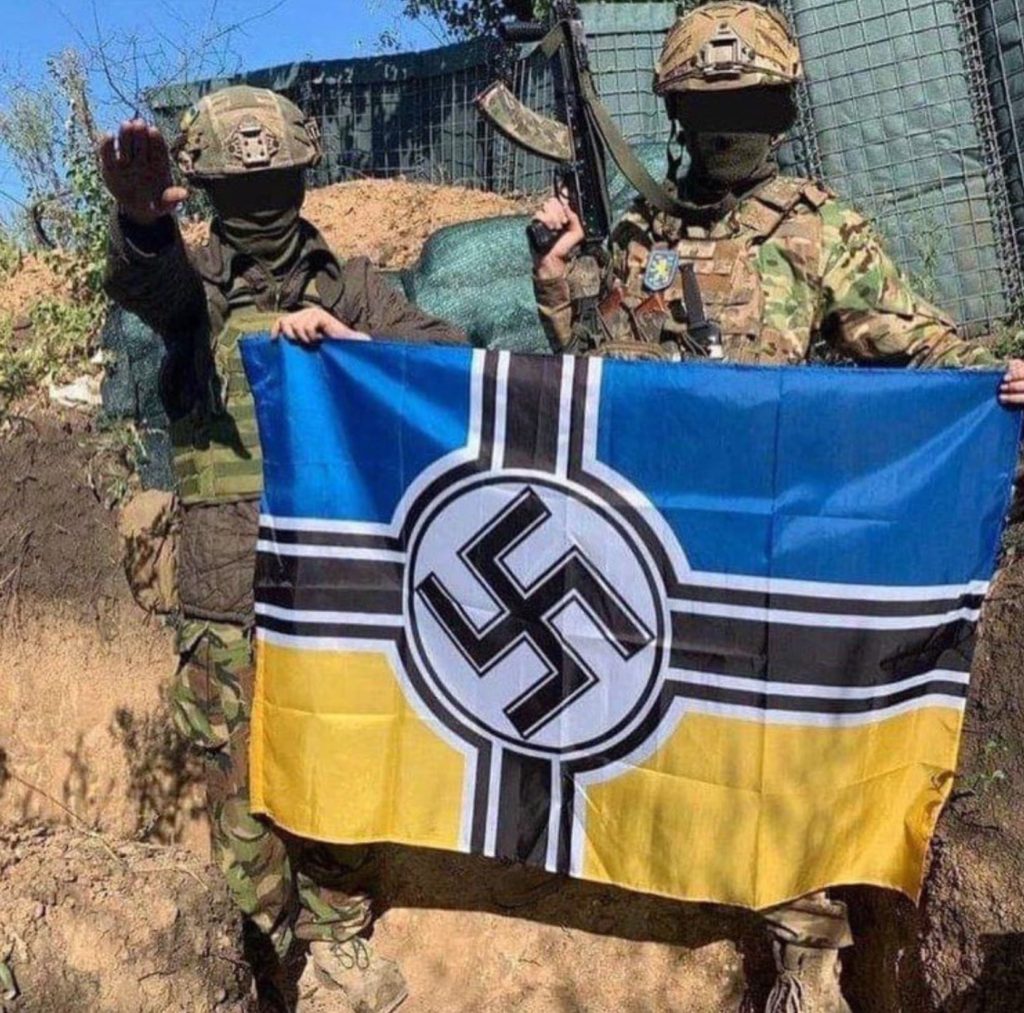
On May 17, the Russian Ministry of Defence confirmed that the surrender of the militants of the nationalist Azov regiment and Ukrainian servicemen, who were blocked at the Azovstal plant in Mariupol began.
Over the past day, 265 militants have laid down their arms and surrendered, including 51 seriously wounded. All those in need of medical care were sent for treatment to the hospital in Novoazovsk, Donetsk People’s Republic. The other were transferred to the village of Elenovka in the Donetsk People’s republic.
The surrender of the “garrison of Mariupol” continues. The Ukrainian fighters are disarmed, then they are sent to Novoazovsk or Elenovka.
On May 17, a Russian military reporter in Mariupol claimed that as of May 16, there were over 2.5 thousand AFU servicemen in the industrial zone, 404 of them were wounded. 55 servicemen were seriously injured. 200 corpses of dead fighters were frozen in refrigerators.
There were also three Russian prisoners, including an officer and two soldiers.
In total, 804 members of the Azov nationalist regiment were hiding in Azovstal. The others were servicemen of the 53rd, 54th, 56th separate brigades of the Armed Forces of Ukraine, the 36th separate brigade of Marines, 501st and 503 separate battalions of marines and 12 brigade The National Guard, which included “Azov”.
The military reporter added that the decision was made not to comment on the situation in Azovstal. The officials claims will be made by the Russian Ministry of Defence.
In an attempt to justify the fall of the Ukrainian fortress, the Minister of Defense of Ukraine called the surrender of the AFU remnants from Azovstal a “delicate situation.”
The Main Directorate of Intelligence of Ukraine stated that the GUR, the AFU, the border service, the National Guard, the SBU, the National Police and Azov are carrying out a special operation to rescue defenders of Mariupol blocked on the territory of the Azovstal plant. If the operation was aimed at the transfer of the nazi fighters to the Russian military, it likely succeeded.
The Kiev regime continuesly claims that all the Ukrainian militants should be exchanged for the Russian prisoners of war. The Russian military officials have not confirmed any exchange so far.
Moreover, on May 17, State Duma Speaker Vyacheslav Volodin ordered to work on the proposal of the members of the State Duma to prohibit the exchange of all Ukrainian Nazis to Ukraine. He added that this issue should be worked out jointly with the Defense and Security Committee.
“You are making the right offer. Nazi criminals should not be exchanged. These are war criminals. We must do everything to ensure that they face trial” Volodin summed up.
“Mama and us at Yosemite, California, 1963”

Leaked Vietnam video
The Ultimate Brownie
This is Betty’s all-time favorite homemade brownie!

Ingredients
- 2/3 cup butter or margarine
- 5 oz unsweetened baking chocolate, cut into pieces
- 1 3/4 cups sugar
- 2 teaspoons vanilla
- 3 eggs
- 1 cup Gold Medal™ all-purpose flour
- 1 cup chopped walnuts
Steps
-
1Heat oven to 350°F. Grease bottom and sides of 9-inch square pan. In 1-quart saucepan, melt butter and chocolate over low heat, stirring constantly. Cool slightly.
-
2In medium bowl, beat sugar, vanilla and eggs with electric mixer on high speed 5 minutes. Beat in chocolate mixture on low speed. Beat in flour just until blended. Stir in walnuts. Spread in pan.
-
3Bake 40 to 45 minutes or just until brownies begin to pull away from sides of pan. Cool completely in pan on cooling rack. For brownies, cut into 4 rows by 4 rows.

After the NATO War is Over
By Batiushka for the Saker Blog
Make no mistake about it: The tragic war that is currently taking place on Ukrainian battlefields is not between the Russian Federation and the Ukraine, but between the Russian Federation and the US-controlled NATO. The latter, also called ‘the collective West’, promotes an aggressive ideology of organised violence, a politically- economically- and militarily-enforced doctrine euphemistically known as ‘Globalism’. This means hegemony by the Western world, which arrogantly calls itself ‘the international community’, over the whole planet. NATO is losing that war, which uses NATO-trained Ukrainians as its proxy cannon fodder, in three spheres, political, economic and military.
Firstly, politically, the West has finally understood that it cannot execute regime change in Moscow. Its pipedream of replacing the highly popular President Putin with is CIA stooge Navalny is not going to happen. As for the West’s puppet-president in Kiev, he is only a creature of Washington and its oligarchs. A professional actor, he is unable to speak for himself, but is a spokesman for the NATO which he loves.
Secondly, economically, the West faces serious resistance to the 6,000 sanctions it has imposed on Russia and Russians. Those sanctions have backfired. In the West, we can testify to this every time we buy fuel or food. The combination of high inflation (10% +) and even higher energy prices, caused almost solely by these illegal anti-Russian sanctions, are threatening the collapse of Western economies, much more than threatening Russia or China. As a result of this reverse effect of sanctions against Russia, the rouble is at a three-year high, standing at about 64 to the US dollar and rising, though immediately after the sanctions it had briefly gone down to 150 to the dollar.
After strenuously denying that they would do it, already most countries in Europe (at least 17 for now), including Germany and Italy, have agreed to open accounts with Gazprombank, as Russia advised them to do and to pay for oil and gas in roubles. And this number is growing by the week. The problems will be even greater with food shortages, as the world food chain is highly integrated and the agricultural production of Russia and the Ukraine (now controlled by Russia) is at least 40% of the world’s grain production. Just days ago it was announced that Russia expects record grain production this year (130 million tonnes). Russia may yet demand payment in roubles for all this as well.
The sanctions against Russia have divided Europe and are threatening to divide NATO. President Erdogan of Turkey, a NATO member, has announced that he would veto the entry to NATO of Finland and Sweden into NATO. At the same time, Russia has announced that it will cut off Finland’s natural gas supply. Swedish leaders are re-thinking their entry to NATO.
Thirdly, militarily, it is clear that the Ukraine, with huge numbers of desertions and surrenders, has no chance of winning the war against Russia. Most of its military equipment has already been wiped out and newly-delivered and often antiquated Western equipment will make little difference, even if it is not destroyed by Russian missiles as soon as it reaches the Ukraine. The conflict could now be over within weeks, rather than months. The US ‘Defense Secretary’ (= Minister for Offense), Lloyd Austin, has desperately called the Russian Defence Minister Sergey Shoigu to beg for a ceasefire. Would you agree to a ceasefire when in less than three months and with only 10% of your military forces you have already occupied an area greater than England inside the Ukraine, an area that produces 75% of Ukrainian GDP?
The panic of financial disaster in the West has begun to set in. As a result, the French President Macron has told President Zelensky (that is, told Washington) to give up part of Ukraine’s sovereignty and at last start serious negotiations with Russia. Macron is also trying to free French mercenaries from Azovstal in Mariupol, but the problem is much bigger than this, as the whole of Europe is facing economic meltdown. And the Italian Prime Minister, Mario Draghi, has asked President Biden to contact President Putin and ‘give peace a chance’. Note that Mario Draghi is a former president of the European Central Bank and a Goldman Sachs puppet – just as Macron is a Rothschild puppet.
There have always been empires and invasions throughout history. However, they have always been local and not been justified as the only possible global ideology, a ‘New World Order’, to be imposed by violence all over the planet. After the NATO war is over, lost by ‘the collective West’, NATO Centralism, the ideology of a ‘Unipolar World’, controlled from Washington, must end. However, Centralism must also come to an end everywhere else, like that under Soviet-period Moscow (1).
However, Nationalism must also come to an end. Here we should remember that the very word ‘Nazism’ comes from the German words for ‘National Socialism’. (Nationalism entails hatred for others, whereas Patriotism means the ability not only to love your own country, but also love the countries of others, not hate their countries). And the Ukraine has a history of Nazism, stretching back over eighty years. Moreover, today’s leading Kiev soldiery are Nazi nationalists and represent the tribalism so typical of Western Europe, responsible in the twentieth century for two huge wars which it spread worldwide. The Nazi Ukrainian cries of ‘Glory to the Ukraine’ and their slogan of ‘Ukraine above Everything’ are slogans of Nazism.
Let us move to a world that is multipolar and multicentric, which has unity in diversity and diversity in unity. If we do not move towards this, we will probably be lost. For a multipolar, multicivilisational and multicultural world, the world of seven billion human beings already, is the only civilized world, the only true international community.
Note: 1. Here anti-Semites will tell you that the Centralism of Soviet-period Moscow was founded by the Bolsheviks, of whom over 80% were Jews. Firstly, it should be pointed out that they were atheist Jews, internationalists like Bronstein/Trotsky, who supported the ‘Third International’. In other words, they were political Zionists (not religious Zionists, indeed, they were anti-religious). And let us recall that a huge number of Jews were and are anti-Zionists and a huge number of Zionists were and are not at all Jews. This is why the Saker rightly uses the term ‘Anglo-Zionism’ for these unipolar centralisers.
Streusel Coffee Cake
Everyone needs a classic coffee cake recipe. Simple to make and a treat to eat, this is it! Our cinnamon Streusel Coffee Cake recipe is the perfect one to wake up and create for a holiday brunch. It only takes 10 minutes of prep time and is made easy with Bisquick™ Original Pancake & Baking Mix.

Ingredients
Cinnamon Streusel
- 1/3 cup Bisquick™ Original pancake & baking mix
- 1/3 cup packed brown sugar
- 1/2 teaspoon ground cinnamon
- 2 tablespoons firm butter or margarine
Coffee Cake
- 2 cups Bisquick™ Original pancake & baking mix
- 2/3 cup milk or water
- 2 tablespoons sugar
- 1 egg

“Mom when in Madrid, 1961”

Cambodia Demands British Museums Return Stolen Khmer Artifacts

It's just a beginning. -MM
Stolen Khmer artifacts from ancient Cambodian temples should be returned now. This is what Cambodian heritage authorities have told London’s Victoria & Albert and British Museum who currently profit from scores of once looted Khmer artifacts.
Until the 7th century AD, Cambodian (Khmer) arts were greatly influenced by Indian Hindu themes. By the 10th century, however, Khmer artisans had formulated their own distinct style of sculpting which scholars say is closer to the wholeness of Egyptian sculpture than it is to Indian styles. Standing sentinel among thousands of jungle temples is the massive Angkor Wat representing the largest religious complex ever built, and Banteay Srei, a comparatively tiny hospital temple.
All Khmer temples are completely covered with sculpted deities, spirits and demons. Garuda is part man and part bird, Apsaras are celestial dancing girls, Dvarapalas are demonic temple guardians with clubs and Gajasimha is a mythical animal with the body of a lion and the head of an elephant. These figures and many more were among the hundreds of sculptures smashed from their plinths, looted, and sold to British and US museums. Now Cambodia wants them back!
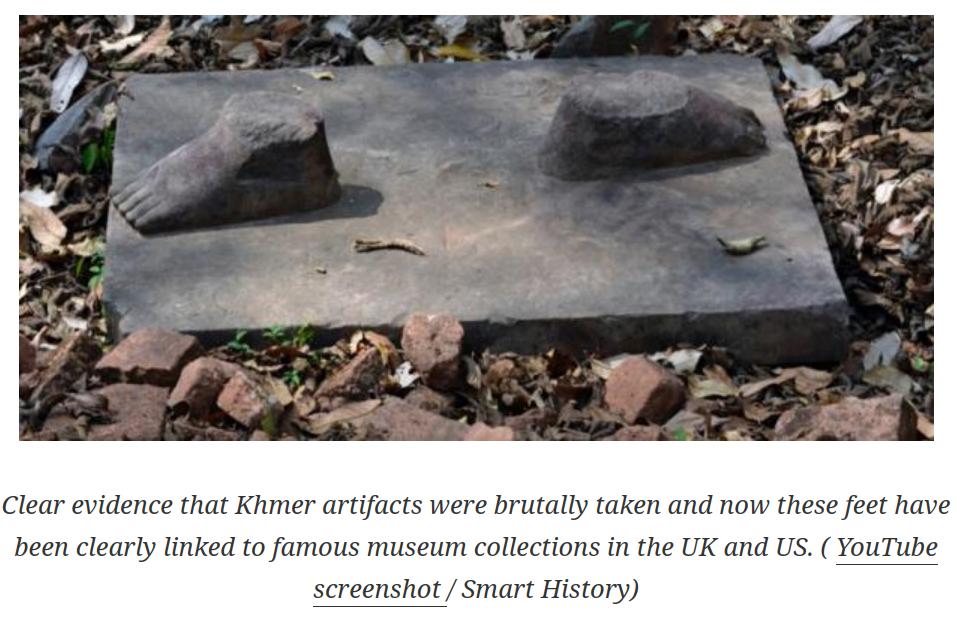
When Stolen Khmer Artifacts Become War Crimes
Cambodia’s culture minister appealed to the Victoria & Albert (V&A) and British Museums (BM) to return scores of Khmer artifacts it claims were “ stolen from its temples.” Believed to enshrine the souls of their kings and ancestors, many of these temple statues were illegally removed from Cambodia by the late Douglas Latchford.
- The Crocodile Stone: Is This a Grisly Artifact of Human Sacrifice?
- Exquisite 12th Century Lion Sculpture Dragged From Reservoir in Cambodia
According to the Washington Post , beginning in the 1970s, Latchford, an English explorer, arts connoisseur and author, helicoptered into remote Cambodia and amassed “one of the world’s largest private collections of Khmer treasures.” The Cambodian Ministry of Culture’s chief legal counsel and the head of its investigative team, Brad Gordon, told the BBC that trading in these items should be “considered a war crime”.
Plundering Ancient Treasures In The Fog Of Modern War
Members of the Communist Party of Kampuchea (Khmer Rouge) ruled Cambodia between 1975 and 1979 and murdered more than two million citizens. They controlled swathes of Cambodia up to the early 90s, and most of the temples were looted during these three chaotic decades. In 2012, Lachford was identified by US prosecutors in a case targeting a New York artifacts dealers , and in 2019 he was charged for smuggling stolen antiquities, but he died in 2020 before going to trial.
Phoeurng Sackona, the Cambodian Ministry of Culture, recently wrote to Nadine Dorries, her British equivalent, informing her that around 100 important cultural treasures that were stolen from sacred temples are now in two London museums. The letter reminded Dorries of the Hague Convention document signed on 14 May 1954 which protects cultural property seized during armed conflicts.
Museologists at the Victoria and Albert Museum said they “welcomed constructive dialogue” and staff at the BM said they would “consider the requests carefully and respectfully.”

A High Class, Low Minded, British Criminal
Brad Gordon said Lachford tried to offload his collection “right up until he went into the hospital and died.” Julia Latchford, Douglas’s daughter, says she has already transferred her entire collection to the Cambodian authorities with five major objects already repatriated. However, about 50 pieces are currently on display at the two London museums generating cash income from tourists.
Sopheap Meas, an archaeologist on the investigative team, said Cambodians believe the statues contain the “soul of a king, a god or maybe an ancestor.” Brad Gordon told the BBC that everyone in the world knew what was happening in Cambodia and that the BM and the V&A “shouldn’t have accepted these pieces.” There is little room for excuses here as Gordon added most of the hundred plus artifacts have “no export licence or permit,” therefore, the two museums are holding “stolen property that needs to come back to Cambodia,” says Gordon.
By Ashley Cowie
Do you want more?
You can find more articles related to this in my latest index; A New Beginning. And in it are elements of the old, some elements regarding the transition, and some elements that look towards the future.
New Beginnings 4.
Articles & Links
Master Index.
- You can start reading the articles by going HERE.
- You can visit the Index Page HERE to explore by article subject.
- You can also ask the author some questions. You can go HERE to find out how to go about this.
- You can find out more about the author HERE.
- If you have concerns or complaints, you can go HERE.
- If you want to make a donation, you can go HERE.
.




Concerning the reality of war,
Just yesterday i received this link:
document of the war- The story of a Ukrainian interpreter who was drafted into military service against the Russian attack –
https://www-jungewelt-de.translate.goog/artikel/427348.ukraine-dokument-des-krieges.html?_x_tr_sl=auto&_x_tr_tl=en&_x_tr_hl=de
original link:
[https://www.jungewelt.de/artikel/427348.ukraine-dokument-des-krieges.html]
War.
Where old men who know each other
send young men who don’t know each other to fight and die.
May the author stay unharmed and see his family again!